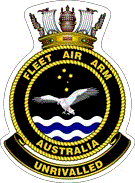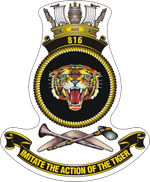
The Royal Australian Navy (RAN) is the naval force of Australia. Following the Federation of Australia in 1901, the ships and resources of the separate colonial navies were integrated into a national force, called the Commonwealth Naval Forces; it was granted its current title in 1911. It is part of the Australian Defence Force along with the Australian Army and Royal Australian Air Force. Originally intended for local defence, it became increasingly responsible for the defence of the region as the British started to diminish its forces in the Pacific.

The Westland Wessex is a British-built turbine-powered development of the Sikorsky H-34. It was developed and produced under licence by Westland Aircraft. One of the main changes from Sikorsky's H-34 was the replacement of the piston-engine powerplant with a turboshaft engine. Early models were powered by a single Napier Gazelle engine, while later builds used a pair of de Havilland Gnome engines.

HMAS Melbourne (R21) was a Majestic-class light aircraft carrier operated by the Royal Australian Navy (RAN) from 1955 until 1982, and was the third and final conventional aircraft carrier to serve in the RAN. Melbourne was the only Commonwealth naval vessel to sink two friendly warships in peacetime collisions.

HMAS Sydney (R17/A214/P214/L134) was a Majestic-class light aircraft carrier operated by the Royal Australian Navy (RAN). She was built for the Royal Navy and was launched as HMS Terrible (93) in 1944, but was not completed before the end of World War II. The carrier was sold to Australia in 1947, completed, and commissioned into the RAN as Sydney in 1948.

The Fleet Air Arm (FAA), known formally as the Australian Navy Aviation Group, is the division of the Royal Australian Navy (RAN) responsible for the operation of aircraft. The FAA was founded in 1947 following the purchase of two aircraft carriers from the Royal Navy. FAA personnel fought in the Korean War and the Vietnam War, and participated in later conflicts and operations from host warships.

HMAS Albatross is the main naval air station for the Royal Australian Navy's (RAN) aviation branch, the Fleet Air Arm. The base, located near Nowra, New South Wales, was formally established in May 1942 as Royal Australian Air Force (RAAF) base RAAF Nowra, then was transferred to the Royal Navy as HMS Nabbington in 1944, and operated as a naval air station until it was decommissioned in late 1945. In 1948, the airfield was commissioned into the RAN as HMAS Albatross, as the primary shore base for the Fleet Air Arm. Since 2011, four squadrons of the Fleet Air Arm operate from Albatross. The current commander of the base is Captain Robyn Phillips, RAN.

No. 9 Squadron was a unit of the Royal Australian Air Force (RAAF). The squadron was formed in early 1939 and saw active service in World War II as a fleet co-operation unit providing aircrews for seaplanes operating off Royal Australian Navy cruisers. It was disbanded in late 1944, but was re-raised in 1962 and later became an Army co-operation unit, flying helicopters in support of Australian troops during the Vietnam War. The squadron was disbanded in 1989 when the RAAF transferred its battlefield helicopters to the Australian Army's aviation regiments.

No. 5 Squadron was a Royal Australian Air Force training, army co-operation and helicopter squadron. The squadron was formed in 1917 as a training unit of the Australian Flying Corps in Britain, readying pilots for service on the Western Front. It subsequently became a naval fleet co-operation squadron, but was later redesignated as No. 9 Squadron RAAF before being re-formed as an army co-operation squadron during World War II. In the mid-1960s, it was re-formed as a helicopter squadron, before being disbanded in December 1989, when it was used to form the Australian Defence Force Helicopter Training School.

851 Squadron was a Royal Australian Navy Fleet Air Arm squadron. The squadron operated over two periods between 1954 and 1984, mainly in the training and transport roles.

816 Squadron is a Royal Australian Navy Fleet Air Arm squadron that started out as a Royal Navy unit 816 Naval Air Squadron.

700 Naval Air Squadron is an experimental test squadron in the Royal Navy’s Fleet Air Arm.

The history of the Royal Australian Navy traces the development of the Royal Australian Navy (RAN) from the colonisation of Australia by the British in 1788. Until 1859, vessels of the Royal Navy made frequent trips to the new colonies. In 1859, the Australia Squadron was formed as a separate squadron and remained in Australia until 1913. Until Federation, five of the six Australian colonies operated their own colonial naval force, which formed on 1 March 1901 the Australian Navy's (AN) Commonwealth Naval Force which received Royal patronage in July 1911 and was from that time referred to as Royal Australian Navy (RAN). On 4 October 1913 the new replacement fleet for the foundation fleet of 1901 steamed through Sydney Heads for the first time.

817 Squadron was a Royal Australian Navy Fleet Air Arm squadron. It was originally formed as part of the Royal Navy's Fleet Air Arm for service during World War II and took part in combat operations in Norway, North Africa, Sicily and off the coast of France. Following the conclusion of hostilities, the squadron was disbanded in 1945. In 1950, it was re-raised as part of the Royal Australian Navy and subsequently took part in the Korean War. Recent deployments have included Operation Falconer, Operation Slipper and Operation Sumatra Assist. In December 2011, the squadron was disbanded.

723 Squadron is a Royal Australian Navy Fleet Air Arm squadron. The squadron was first raised in 1952 and throughout its history has served operationally during the Vietnam War, the Gulf War and in East Timor. It currently operates as a helicopter training squadron and is based at HMAS Albatross at Nowra, New South Wales.

815 Naval Air Squadron is a squadron of the Fleet Air Arm, part of the Royal Navy, based at RNAS Yeovilton in Somerset; it is the Navy's front line Wildcat Naval Air Squadron. It comprises AgustaWestland Wildcat HMA.2 helicopters and is the largest helicopter squadron in western Europe.
724 Squadron was a Royal Navy Fleet Air Arm and Royal Australian Navy Fleet Air Arm flying squadron. The squadron was formed for the first time in 1945 and was last disbanded in 1984.
Operation Navy Help Darwin was a disaster relief operation initiated by the Royal Australian Navy (RAN) following the destruction of Darwin, Northern Territory by Cyclone Tracy during the night of 24–25 December 1974. 13 ships, 11 aircraft, and 3,000 personnel were sent to Darwin in the largest disaster relief operation undertaken by the RAN in its history. The RAN task force was present from 31 December 1974 to 31 January 1975.

The first involvement Australia had with naval aviation was in 1911, when an Australian-born Royal Navy officer became one of the first four naval officers to receive pilot qualifications. During World War I, the Royal Australian Navy (RAN) experienced several forms of airborne operation, with HMAS Brisbane operating a seaplane, while HMA Ships Sydney and Australia were used for experiments with aircraft launch platforms. An aircraft embarked aboard Sydney was also involved in one of the first naval air battles. Several Australians also flew as part of the Royal Naval Air Service.

The McDonnell Douglas A-4G Skyhawk is a variant of the Douglas A-4 Skyhawk attack aircraft developed for the Royal Australian Navy (RAN). The model was based on the A-4F variant of the Skyhawk, and was fitted with slightly different avionics as well as the capacity to operate AIM-9 Sidewinder air-to-air missiles. The RAN received ten A-4Gs in 1967 and another ten in 1971, and operated the type from 1967 to 1984.

The Royal Australian Navy operated Grumman S-2 Tracker anti-submarine warfare aircraft from 1967 to 1984. The type flew from the aircraft carrier HMAS Melbourne and shore bases. A total of 32 Trackers were purchased in two batches which were delivered in 1967 and 1977.



















